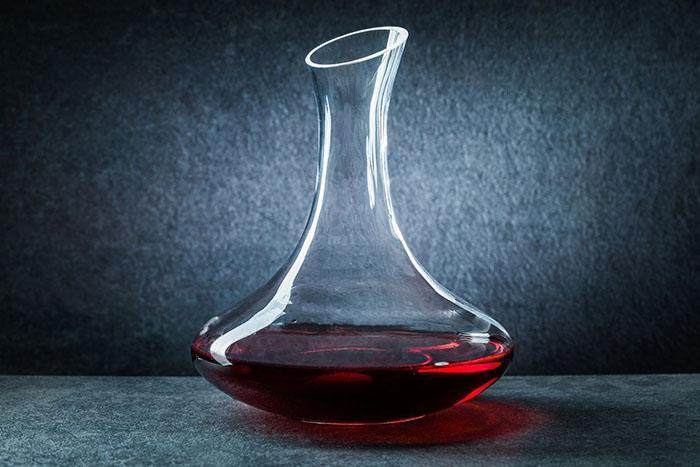Ever wondered what a decanter is and why it’s such an essential item for wine lovers?
Simply put, a decanter is a special vessel, usually made of glass or crystal used to improve the taste of your favorite wines.
You Are Watching: What Is A Decanter Updated 07/2025
This article will guide you through understanding what a decanter is, its importance in presenting and enhancing the flavor of wine, and tips on how to choose one that suits your needs best.
So, let’s dive into the captivating world of decanters together!
What is a Decanter?

Definition and purpose
A decanter, in its simplest expression, is a vessel that holds the decantation of liquids like wine.
Traditionally made from glass or crystal, it serves the crucial role of separating wine from any potential sediment which may alter the taste and visual appeal.
In addition to improving appearance and flavor by eliminating sediment, another fundamental purpose of a decanter is to allow the wine to breathe – introducing oxygen into the liquid.
This process enhances the overall quality and experience when you serve your chosen vintage from bottle to glass.
As far as design goes, a typical wine decanter boasts a narrower neck alongside a wider base. This specific engineering increases surface area for aerating – allowing more oxygen interaction with your poured liquor enhancing its essence even further.
Decanters are not confined only to wines; other beverages such as whiskey get their fair share too!
Read More : Types Of Mezcal Updated 07/2025
Furthermore, they also find use in various industrial applications like chemical engineering and water treatment due to their exceptional utility in controlling sediments while pouring out clear liquids.
Types of decanters
Decanters come in various shapes and designs, each serving a specific purpose.
Here are some of the most common types of decanters:
- Wine Decanter: This is the most popular type of decanter and is specifically designed for wine. It features a wide base and a narrow neck to maximize surface area for aeration.
- Crystal Decanter: Made from high-quality crystal, these decanters not only serve their functional purpose but also add an elegant touch to any table setting.
- Glass Decanter: These decanters are made from glass and offer a more affordable option compared to crystal decanters. They still provide the same functionality but may lack the same aesthetic appeal.
- Whiskey Decanter: Specifically designed for whiskey enthusiasts, whiskey decanters are often shorter and wider than wine decanters. They allow the spirit to breathe and develop its flavors before being served.
- Red Wine Decanter: Designed specifically for red wines, these decanters typically have a larger surface area to promote maximum aeration, unlocking the full potential of complex red wines.
- Wine Aerator: While not technically a decanter, wine aerators are popular alternatives that instantly oxygenate wine as it is poured into the glass. They can enhance the flavors and aromas of wine in seconds.
- Wine Carafe: Similar to traditional decanters, wine carafes offer a stylish way to serve and aerate wine. They usually have a curved design that allows for easy pouring without any spills.
How to Use a Decanter

Decanting process
Decanting is a process that involves transferring liquid from one container to another in order to separate it from any sediment or debris. When it comes to wine, decanting can greatly enhance its taste and appearance.
Here’s a step-by-step guide on how to properly decant wine:
- Choose the right decanter: Select a glass or crystal decanter that maximizes the wine’s exposure to air, allowing it to breathe and develop its flavors.
- Stand the wine bottle upright: Before opening the bottle, make sure it is stood upright for at least 24 hours. This allows any sediment to settle at the bottom of the bottle.
- Open the bottle carefully: Remove the cork or cap from the wine bottle, being mindful not to disturb the sediment.
- Slowly pour the wine: Gently pour the wine into the decanter, ensuring a smooth and steady flow. Take your time with this step to prevent any sediment from mixing with the liquid.
- Keep an eye on the pour: As you near the end of pouring, be cautious not to pour too much as there may be some sediment left in the bottle.
- Let it breathe: Leave the decanted wine uncovered for about 30 minutes before serving. This will allow oxygen to interact with the liquid, bringing out its aromas and flavors.
- Serve and enjoy: Once properly aerated, pour your beautifully decanted wine into glasses and savor every sip.
Aeration benefits
Aeration, the process of introducing oxygen to wine through decanting, offers several benefits that enhance the drinking experience.
As wine reacts with air, it undergoes a chemical transformation that softens and opens up its flavors and aromas.
Aeration not only allows these complex characteristics to be fully appreciated but also helps to smooth out any harsh or sharp edges in the wine.
Additionally, when poured into a decanter, the increased surface area exposes more of the wine to oxygen, which further accelerates this breathing process.
Whether you’re enjoying a rich red or an elegant white, decanting allows your chosen beverage to reach its full potential by giving it room to breathe and develop its unique qualities.
Read More : What Is Drambuie Updated 07/2025
Another advantage of aerating wine is the removal of any sediment that may have accumulated during maturation. Sediment consists of solid particles like tannins and pigments that are naturally present in aged wines.
When pouring from bottle to glass directly, sediment can get disturbed and mix into your drink – resulting in an unpleasant gritty texture on the palate.
However, by carefully transferring your wine into a decanter while leaving behind sediment at the bottom of the bottle ensures a clean pour free from unwanted debris.
Choosing the Right Decanter

Decanter materials
Decanters are available in a variety of materials to suit different preferences and needs. Here are some common decanter materials used in the production of these vessels:
- Glass: Glass decanters are widely popular due to their transparency, allowing you to appreciate the color and clarity of the wine inside. They are also affordable and easy to clean.
- Crystal: Crystal decanters are prized for their elegance and sophistication. They often have intricate designs and can enhance the visual appeal of your dining table or bar cart. Crystal is also known for its durability and ability to refract light, creating a dazzling display.
- Lead-Free Crystal: For those concerned about lead content, lead-free crystal decanters provide a safe alternative without compromising on quality or aesthetics. These decanters offer similar attributes as traditional crystal but without the potential health risks associated with lead.
- Stainless Steel: Stainless steel decanters are less common but offer unique advantages. They are highly durable, resistant to scratches, and retain temperature effectively, making them ideal for serving chilled wines or spirits.
- Ceramic: Ceramic decanters add an artistic touch to your wine service experience. They come in various shapes and styles, including hand-painted options that showcase creativity and craftsmanship.
- Wood: Wooden decanters bring warmth and rustic charm to your home bar or dining room decor. While not as common as other materials, they can be a stylish choice for those seeking a more traditional or vintage aesthetic.
Decanter features
A decanter comes in various shapes and designs, each with its own unique features.
When choosing a decanter, consider the following features:
- Material: Decanters are commonly made from glass or crystal. Glass decanters are sturdy and affordable, while crystal decanters add elegance and sophistication to any table setting.
- Shape: The shape of a decanter plays a role in how the wine or liquor is aerated. Look for a decanter with a wide base and a narrow neck, as this design maximizes the wine’s exposure to oxygen, enhancing its flavors and aromas.
- Capacity: Consider the volume of liquid you typically plan to decant. Decanters come in various sizes, but most have a capacity equivalent to one standard bottle of wine.
- Stopper or lid: Some decanters come with stoppers or lids to seal the container when not in use. This feature helps preserve the wine’s freshness and prevent any unwanted aromas from entering the decanter.
- Easy pouring: Look for a decanter with a well-designed spout that allows for smooth pouring without spills or drips.
Conclusion
In conclusion, a decanter is an essential tool for any wine or liquor enthusiast. It not only helps to separate sediment from the liquid but also allows the beverage to breathe and improve in taste.
Whether you choose a glass or crystal decanter, the key is to pour slowly and let it aerate for optimum enjoyment.
So, next time you uncork that special bottle, consider using a decanter to elevate your drinking experience.
Cheers!
Sources: https://chesbrewco.com
Category: Wine










